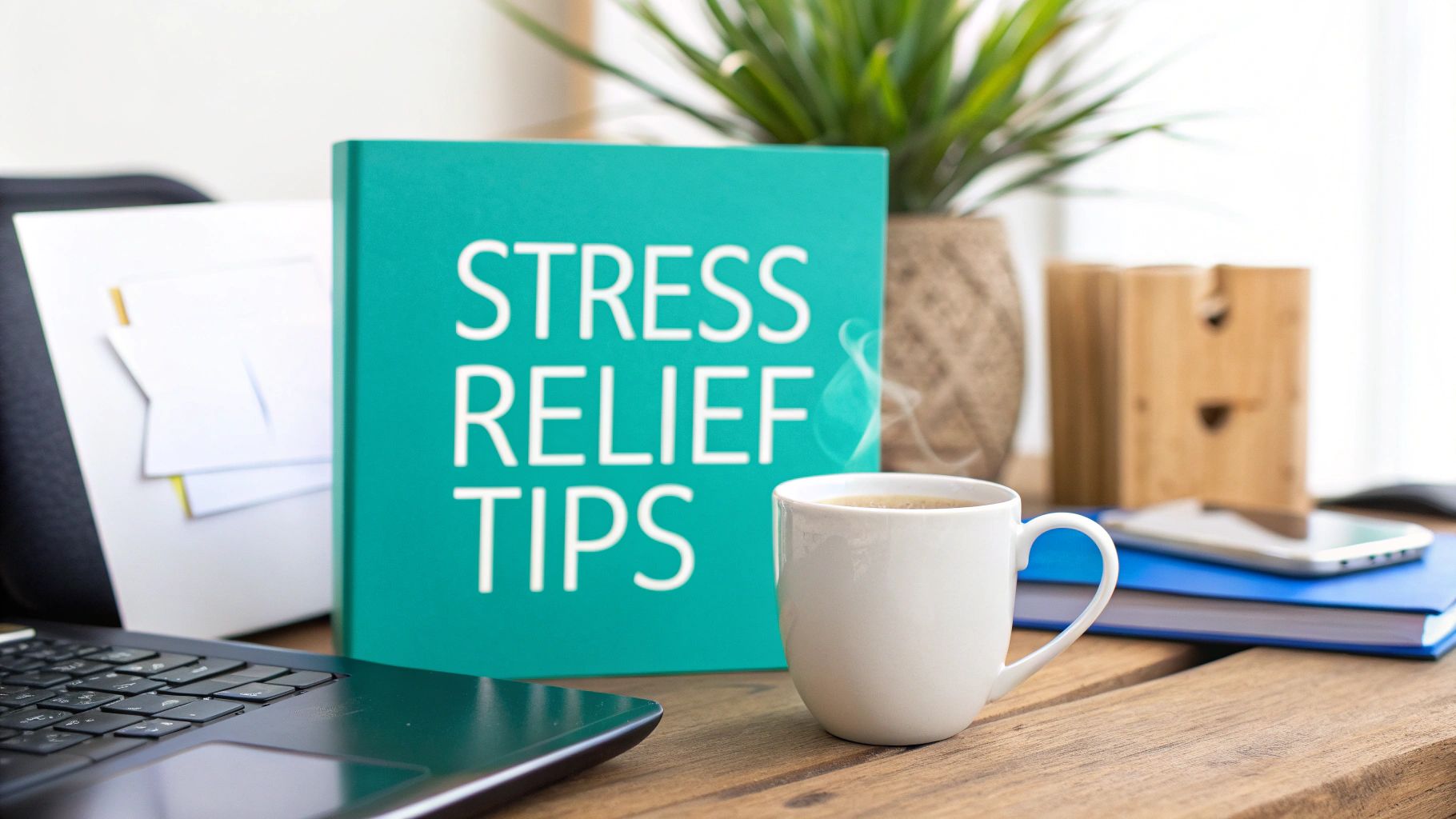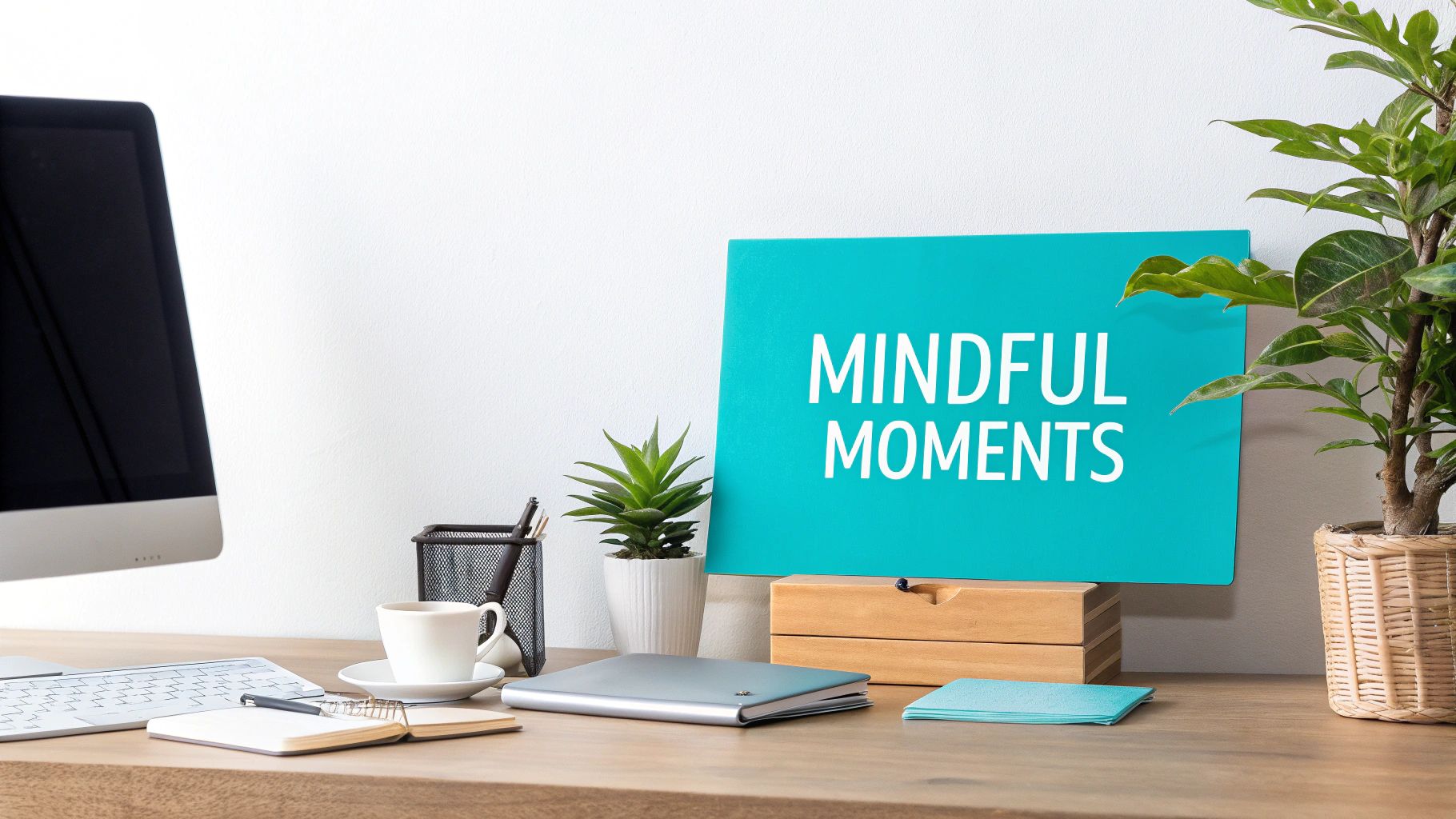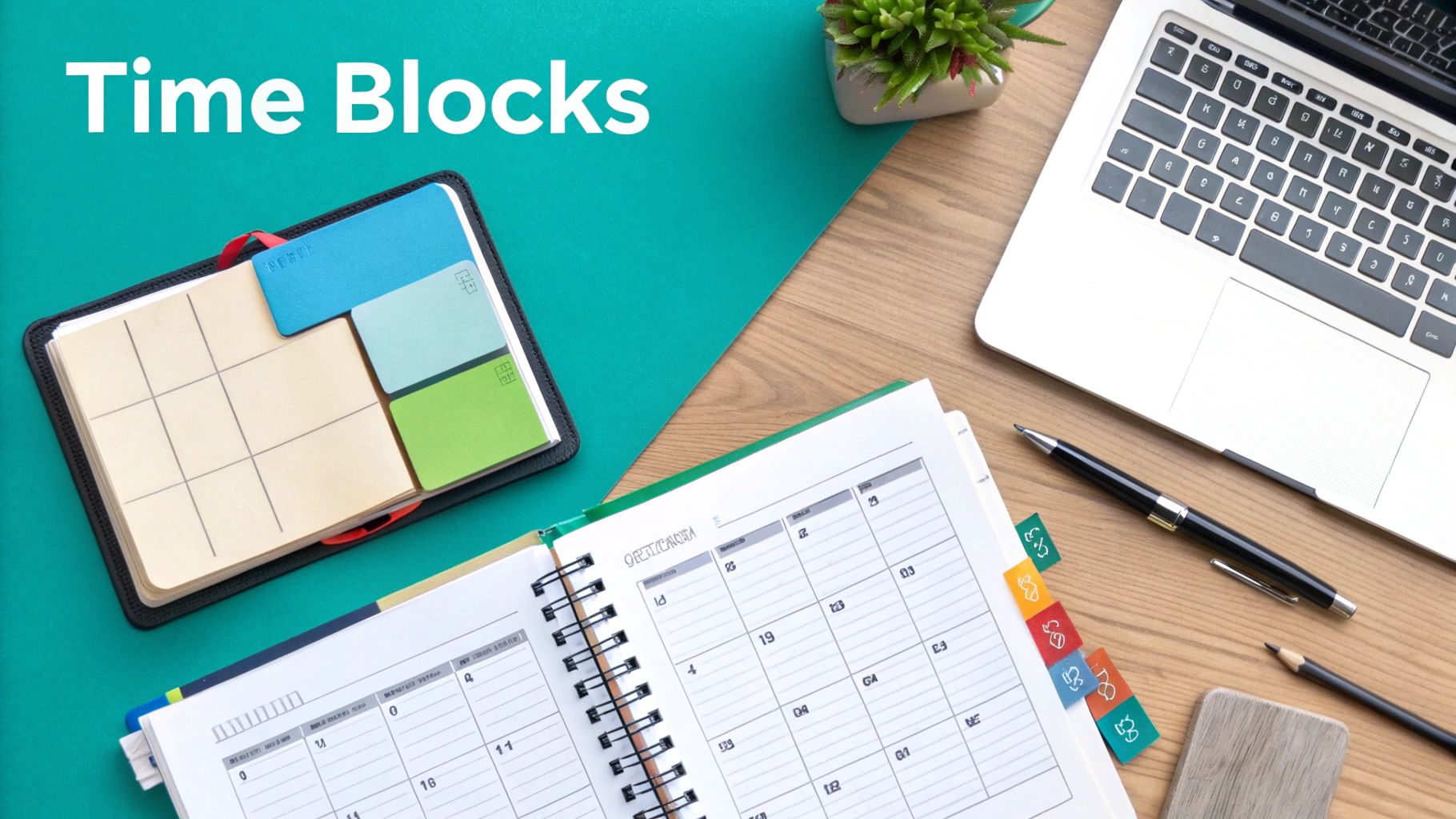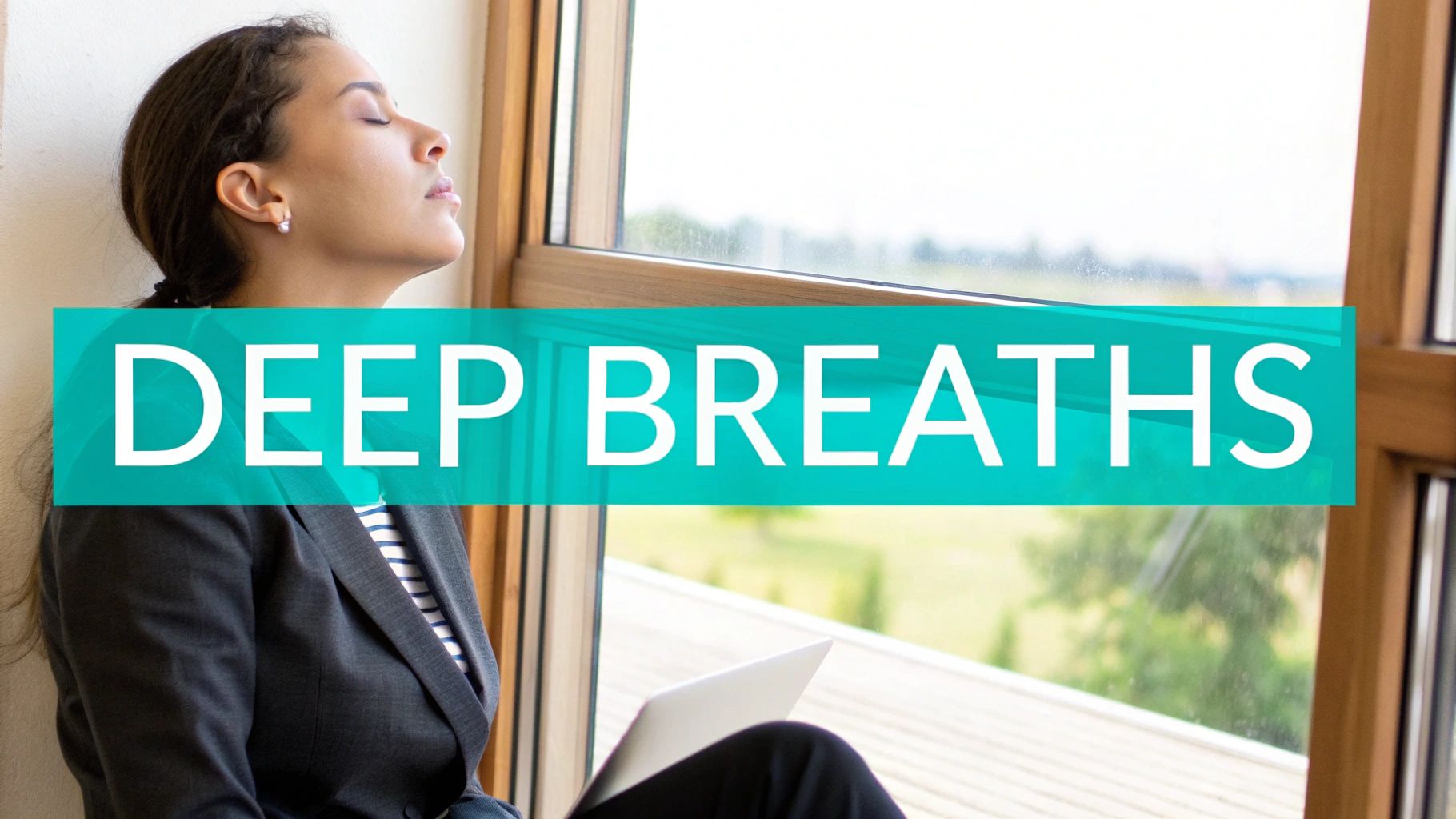

· By Annemarie
8 Effective Work Stress Management Techniques for 2025
In today's fast-paced professional world, the pressure to perform can feel relentless, leading to chronic stress that impacts not just productivity but overall well-being. The constant deadlines, overflowing inboxes, and high expectations can leave even the most resilient individuals feeling overwhelmed and heading toward burnout. But what if you could reclaim control and navigate your workday with more calm and clarity? This comprehensive guide moves beyond generic advice to offer actionable, evidence-based work stress management techniques designed for busy professionals.
This listicle explores eight powerful strategies you can implement immediately. From mindfulness practices that sharpen focus to time management systems that restore order, you will find practical tools to build resilience and create a healthier relationship with your work. We will cover specific methods like Progressive Muscle Relaxation, Cognitive Reframing, and the crucial art of setting firm boundaries. Let's dive into the techniques that can transform your professional life, helping you manage pressure effectively and find a more sustainable path to success.
1. Mindfulness Meditation
Mindfulness meditation is a powerful mental training practice that involves focusing your attention on the present moment. Instead of getting caught up in the whirlwind of workplace demands, you learn to observe your thoughts, feelings, and bodily sensations without judgment. This technique creates a crucial mental buffer between a stressful trigger and your reaction, allowing for a more composed and intentional response. It's one of the most effective work stress management techniques because it directly targets the cognitive and emotional roots of stress.

This practice isn't just a trend; it's backed by corporate success stories. Google's "Search Inside Yourself" program has famously improved employee emotional intelligence and resilience. Similarly, Aetna's mindfulness initiative reportedly saved the company $3,000 per employee in healthcare costs while boosting productivity. These examples show how a simple mental practice can yield tangible business benefits.
How to Implement Mindfulness at Work
Getting started with mindfulness doesn't require a silent retreat or hours of dedication. You can integrate this practice seamlessly into your workday with simple, actionable steps. The goal is to build a consistent habit, not to achieve immediate perfection.
- Start Small: Begin with just five minutes daily. Use a portion of your lunch break or the quiet moments before your workday officially starts.
- Use Guided Apps: Leverage technology to your advantage. Apps like Headspace or Calm offer structured, guided sessions designed for beginners and busy professionals.
- Practice Micro-Mindfulness: You don't always need a formal session. Before a stressful meeting, take three deep, intentional breaths. Focus solely on the sensation of the air entering and leaving your body to ground yourself.
- Set Reminders: Use your phone or calendar to set reminders for "mindful moments" throughout the day. A simple prompt can be enough to get you to pause, breathe, and reset.
Key Insight: Mindfulness is not about emptying your mind or stopping thoughts. It's about changing your relationship with your thoughts, observing them as a neutral witness rather than letting them control your emotional state.
By consistently practicing mindfulness, you can enhance your focus, improve emotional regulation, and significantly reduce your body's physiological stress response, making it a cornerstone of modern work stress management.
2. Time Blocking and Priority Management
Time blocking is a systematic approach to managing your workload by allocating specific, non-negotiable time slots to different tasks. Instead of reacting to a never-ending to-do list, you proactively schedule your day, creating a clear roadmap that reduces the mental load of deciding what to do next. This method transforms a chaotic schedule into an organized plan, which is why it stands out as one of the most effective work stress management techniques for combating overwhelm and last-minute panic.

This structured approach is championed by top-performing companies. Shopify famously implemented a "No Meeting Wednesday" policy, a large-scale time block dedicated to uninterrupted deep work. Similarly, Microsoft's integration of "Focus Time" into Outlook encourages employees to protect their calendars for concentrated effort. These examples demonstrate how creating intentional structure reduces stress and boosts productivity on a company-wide scale.
How to Implement Time Blocking at Work
Adopting time blocking doesn’t require complex software; it’s about a shift in mindset from being reactive to being proactive. You can start building this habit with a few simple, actionable steps that fit into any professional's workflow.
- Schedule Your Priorities: Identify your most critical tasks for the day and schedule them during your peak energy hours. This ensures your best mental resources go toward your most important work.
- Batch Similar Tasks: Group related activities together. For example, block out one hour to respond to all non-urgent emails instead of checking your inbox sporadically throughout the day. This minimizes context switching and improves focus.
- Include Buffer Time: Don't schedule your day back-to-back. Add 10-15 minute buffers between meetings or tasks to allow for transitions, a quick stretch, or unexpected interruptions without derailing your entire schedule.
- Review and Adapt Weekly: At the end of each week, take 15 minutes to review your time blocks. Identify what worked and what didn't, and adjust your plan for the following week accordingly.
Key Insight: Time blocking isn't about rigid control over every minute. It's about making intentional decisions about where your focus goes, giving you a sense of agency over your workday and preventing your time from being hijacked by others' priorities.
By consistently applying time blocking and priority management, you can create a more predictable and less stressful work environment, ensuring that you control your day instead of letting your day control you.
3. Progressive Muscle Relaxation (PMR)
Progressive Muscle Relaxation (PMR) is a deep relaxation technique based on the simple practice of tensing, or tightening, one muscle group at a time followed by a relaxation phase with release of the tension. This method, developed by Dr. Edmund Jacobson, works on the principle that mental calmness is a natural result of physical relaxation. It is one of the most direct work stress management techniques because it physically purges the tension that accumulates in the body from tight deadlines and high-pressure situations.

This powerful mind-body technique isn't just clinical; it's highly practical in corporate settings. Major companies like Johnson & Johnson have incorporated PMR training into their employee wellness programs to reduce burnout. Similarly, the Mayo Clinic champions PMR in its workplace health initiatives to help healthcare professionals manage the intense physical and emotional demands of their roles, demonstrating its effectiveness in even the most high-stakes environments.
How to Implement PMR at Work
You don’t need a quiet room or a yoga mat to benefit from PMR; its biggest advantage is its adaptability. You can practice it discreetly at your desk or during a short break to release built-up physical stress and reset your nervous system.
- Start with Key Tension Zones: If you're short on time, focus on common stress-holding areas. Tense your shoulders by raising them to your ears for 5 seconds, then release. Clench and unclench your fists.
- Use It Before High-Stakes Events: Practice a quick, full-body PMR sequence before an important presentation or difficult conversation to calm your physical stress response and clear your mind.
- Combine with Deep Breathing: Enhance the effect by inhaling as you tense a muscle group and exhaling slowly as you release. This combination sends a powerful relaxation signal to your brain.
- Practice During Your Commute: If you're a passenger or stuck in traffic, discreetly tense and release your legs, feet, and hands to make a stressful part of your day more productive and calming.
Key Insight: The power of PMR lies in the contrast. By intentionally creating and then releasing tension, you become more aware of what physical relaxation feels like, making it easier to identify and release involuntary tension throughout the day.
By regularly practicing PMR, you can lower your blood pressure, reduce muscle tension, and gain a tangible tool to combat the physical symptoms of workplace stress as they arise.
4. Deep Breathing Exercises
Deep breathing exercises are simple yet profound techniques that directly influence your body's physiological stress response. By consciously controlling your breath, you activate the parasympathetic nervous system, which acts as a natural brake on the fight-or-flight reaction. This intentional breathing lowers your heart rate, reduces blood pressure, and sends calming signals to your brain. It's one of the most accessible work stress management techniques because it can be done anywhere, at any time, providing immediate relief during high-pressure moments.

The power of controlled breathing is validated in high-stakes professions. Navy SEALs famously use "box breathing" to stay calm and focused in life-threatening situations, while emergency responders utilize tactical breathing to manage adrenaline. On the corporate side, Apple integrates "Breathe" reminders into its Apple Watch, encouraging users to pause and regulate their stress. These examples demonstrate that mastering your breath is a fundamental skill for maintaining composure under pressure.
How to Implement Deep Breathing at Work
Integrating deep breathing into your workday requires no special equipment, only intention. The key is to use these techniques proactively to manage stress before it escalates, as well as reactively to calm down when feeling overwhelmed.
- Practice the 4-7-8 Technique: Popularized by Dr. Andrew Weil, this technique is a powerful stress reducer. Inhale through your nose for a count of 4, hold your breath for a count of 7, and exhale completely through your mouth for a count of 8.
- Use 'Box Breathing': Inhale for 4 seconds, hold for 4 seconds, exhale for 4 seconds, and hold again for 4 seconds. Repeat this cycle 3-5 times before a stressful meeting or phone call.
- Set Hourly Reminders: Use a calendar or phone alert to remind you to take just three deep, diaphragmatic (belly) breaths every hour. This simple habit can prevent stress from accumulating throughout the day.
- Link Breathing to Routine Tasks: Practice deep breathing while performing a routine task, like reading emails or walking to another office. This pairs the calming exercise with a common work activity, making it an automatic habit.
Key Insight: The effectiveness of deep breathing lies in its ability to hijack the body's automatic stress response. A long, slow exhale is a direct signal to your nervous system that you are safe, counteracting the rapid, shallow breathing that accompanies anxiety.
By making conscious breathing a regular part of your routine, you can gain immediate control over your physiological state, enhancing your resilience and ability to perform effectively under pressure.
5. Setting Boundaries and Saying No
Setting boundaries is a crucial skill that involves clearly defining your professional limits, availability, and commitments. It's the practice of protecting your time and energy by consciously deciding what you will and will not take on. This technique is one of the most proactive work stress management techniques because it directly prevents the overwhelm and burnout caused by overcommitment, ensuring a sustainable and healthy workload.
This concept is championed by leaders like Arianna Huffington, who advocates for work-life boundaries to prevent burnout. Similarly, companies like Buffer encourage transparent communication about capacity, and many European nations have established "right to disconnect" laws, legally protecting employees' personal time. These examples highlight a global shift towards recognizing that clear boundaries are essential for both employee well-being and high performance.
How to Implement Boundaries at Work
Learning to set boundaries is a skill that strengthens with practice. It’s not about being unhelpful or uncooperative; it's about being strategic and realistic about your capacity. Start with small, consistent actions to build confidence and establish new norms with your colleagues.
- Use Buffer Phrases: Instead of an immediate "yes," use phrases like, "Let me check my capacity and get back to you." This gives you time to assess the request without pressure.
- Offer an Alternative: When you must decline, try to offer a different solution. For instance, "I can't help with that this week, but I could look at it next Monday" or "I don't have the expertise, but [Colleague's Name] might be a great person to ask."
- Define Your Availability: Set specific times for checking and responding to emails and messages. Communicate these availability windows to your team to manage expectations.
- Start Small: Practice saying no to low-stakes requests first. This builds the confidence you'll need for more significant or challenging situations.
Key Insight: Setting a boundary is not a rejection of the person making the request. It is a preservation of your own ability to deliver high-quality work and maintain your well-being, which ultimately benefits everyone.
By consistently setting and communicating your boundaries, you can take control of your workload and protect your personal time. For more strategies, you can learn more about how to maintain work-life balance on enjoyupside.com.
#upside #enjoyupside #upsidejelly #livemore #hangovercure #hangoverprevention #fighthangovers #preventhangovers #HangoverRelief #MorningAfter #PartySmarter #HydrationStation #WellnessVibes #RecoverFaster #NoMoreHangovers #HealthyParty #HangoverHacks #FeelGoodMorning #NightlifeEssentials #HangoverFree #SupplementGoals #PostPartyPrep #GoodVibesOnly #HealthAndParty #HangoverHelper #UpsideToPartying
6. Regular Physical Exercise and Movement
Regular physical exercise is one of the most powerful and scientifically-backed work stress management techniques available. It directly combats the physiological effects of stress by reducing stress hormones like cortisol and adrenaline while stimulating the production of endorphins, the body's natural mood elevators. This creates a powerful shift, offering mental clarity and emotional resilience that is crucial in a high-pressure work environment.
This principle is actively championed by leading companies. Nike provides extensive running trails and fitness centers on its campus, while Patagonia famously offers flexible schedules to let employees surf or hike. Even tech pioneers like Steve Jobs were known for holding "walking meetings" to foster creativity and reduce sedentary stress. These examples demonstrate that integrating movement into the workday isn't a luxury; it's a strategic investment in employee well-being and productivity.
How to Implement Physical Activity at Work
You don't need to be a marathon runner to reap the benefits. Integrating consistent movement into your daily routine is simpler than you think and can be adapted to any job or fitness level. The key is to make activity a non-negotiable part of your day.
- Schedule Walking Meetings: For brainstorming or one-on-one check-ins, take the conversation outside. The fresh air and light activity can stimulate new ideas and break the monotony of the office.
- Use Your Breaks Wisely: Dedicate your lunch break to a brisk walk, a quick gym session, or a series of stretches. Even 15-20 minutes of movement can drastically improve your afternoon focus.
- Practice "Exercise Snacking": Every hour, take a 5-minute break for simple desk exercises like squats, lunges, or stretching. Set a timer to remind yourself to get up and move.
- Optimize Your Commute: Park farther away from the office, get off public transit one stop early, or take the stairs instead of the elevator. These small changes add up significantly over time. Learn more about how to boost energy naturally on enjoyupside.com.
#upside #enjoyupside #upsidejelly #livemore #hangovercure #hangoverprevention #fighthangovers #preventhangovers #HangoverRelief #MorningAfter #PartySmarter #HydrationStation #WellnessVibes #RecoverFaster #NoMoreHangovers #HealthyParty #HangoverHacks #FeelGoodMorning #NightlifeEssentials #HangoverFree #SupplementGoals #PostPartyPrep #GoodVibesOnly #HealthAndParty #HangoverHelper #UpsideToPartying
Key Insight: The goal is consistency, not intensity. Short, regular bursts of activity are more effective for managing daily work stress than infrequent, high-intensity workouts.
By making physical movement a regular part of your professional life, you build a powerful defense against burnout, boost your energy levels, and enhance your cognitive function, making it an essential tool for long-term career success.
7. Cognitive Reframing and Perspective Shifts
Cognitive reframing is a psychological technique focused on identifying and changing negative or unhelpful thought patterns related to work stress. It operates on the principle that our emotional response to a situation is driven not by the event itself, but by our interpretation of it. By consciously challenging and altering these interpretations, you can fundamentally change your stress response, turning anxiety and frustration into opportunities for growth and problem-solving. This makes it one of the most proactive work stress management techniques available.
This method is the cornerstone of Cognitive Behavioral Therapy (CBT), a highly effective approach to mental wellness. In the corporate world, companies like American Express have integrated resilience training programs that teach employees how to reframe challenges and maintain a positive outlook. Similarly, executive coaching often focuses heavily on mindset shifts, helping leaders navigate high-pressure environments by altering their perspective on setbacks and failures.
How to Implement Cognitive Reframing at Work
Putting this technique into practice involves becoming more aware of your internal dialogue and actively guiding it towards a more productive direction. It's about building a new mental habit that serves you better under pressure.
- Keep a Thought Journal: For one week, write down stressful situations and the automatic thoughts that follow. This helps you identify recurring negative patterns.
- Challenge Your Thoughts: When you catch a negative thought like "I'm going to fail this presentation," ask yourself: "Is this 100% true? What's a more balanced perspective?"
- Practice the 10-10-10 Rule: Ask yourself if the stressful issue will matter in 10 minutes, 10 months, or 10 years. This simple question helps put temporary problems into a broader, less intimidating context.
- Focus on the Learning Opportunity: Instead of viewing a mistake as a failure, reframe it by asking, "What can I learn from this experience to improve next time?"
Key Insight: Cognitive reframing isn't about ignoring problems or engaging in toxic positivity. It's about realistically assessing a situation and choosing the most empowering and constructive perspective from which to approach it.
By regularly practicing cognitive reframing, you gain control over your emotional reactions, build mental resilience, and reduce the chronic stress that can undermine your performance and well-being. This mental discipline complements other physical and biological approaches, such as understanding what adaptogenic herbs are and how they help the body manage stress.
#upside #enjoyupside #upsidejelly #livemore #hangovercure #hangoverprevention #fighthangovers #preventhangovers #HangoverRelief #MorningAfter #PartySmarter #HydrationStation #WellnessVibes #RecoverFaster #NoMoreHangovers #HealthyParty #HangoverHacks #FeelGoodMorning #NightlifeEssentials #HangoverFree #SupplementGoals #PostPartyPrep #GoodVibesOnly #HealthAndParty #HangoverHelper #UpsideToPartying
8. Social Support and Communication
Building strong professional and personal relationships is a fundamental, yet often overlooked, component of managing workplace pressure. Social support acts as a powerful buffer, providing emotional validation, practical assistance, and diverse perspectives on challenges. Instead of isolating yourself with your stress, actively communicating and connecting with others creates a safety net, making it one of the most resilient work stress management techniques.
This principle is embedded in the cultures of many successful companies. Salesforce champions its "Ohana" (family) culture, fostering deep connections and support systems among employees. Similarly, Microsoft’s Employee Resource Groups (ERGs) create communities where individuals can find peer support and share experiences. These examples demonstrate that fostering a connected, communicative environment is a strategic investment in employee well-being and stress reduction.
How to Implement Social Support at Work
You don’t need an official program to start building your support network. Integrating small, consistent actions into your routine can significantly enhance your sense of connection and reduce feelings of isolation. The goal is to build genuine relationships over time.
- Schedule Check-ins: Intentionally schedule a 15-minute virtual coffee or a walk with a trusted colleague each week. Use this time to connect on a human level, not just to discuss work tasks.
- Join or Create Groups: Participate in your company’s Employee Resource Groups, professional associations, or even an informal lunch club. If one doesn't exist for your interests, take the initiative to start one.
- Offer Help Proactively: Building a support network is a two-way street. Be the colleague who offers assistance when you see someone is overwhelmed. This act of giving strengthens bonds and encourages reciprocity.
- Maintain Outside Friendships: Don't let work consume your entire social life. Nurturing friendships outside your professional circle provides essential perspective and a space to disconnect from job-related stressors.
Key Insight: Social support is not about complaining or venting without purpose. It's about constructive communication, sharing vulnerabilities with trusted peers, and collaboratively finding solutions or simply feeling understood.
By actively cultivating your social connections, you build a resilient support system that can help you navigate the inevitable ups and downs of your career, making stress feel more manageable and less isolating.
Work Stress Management Techniques Comparison
| Technique | Implementation Complexity 🔄 | Resource Requirements ⚡ | Expected Outcomes 📊 | Ideal Use Cases 💡 | Key Advantages ⭐ |
|---|---|---|---|---|---|
| Mindfulness Meditation | Moderate – requires consistent daily practice | Low – no special equipment needed | Reduced stress, improved focus, emotional regulation | Stress reduction, enhancing focus, anywhere practice | Scientifically proven, builds resilience, portable |
| Time Blocking and Priority Management | Moderate to High – initial setup and discipline required | Medium – calendar/tools integration | Increased productivity, better workload management | Task management, avoiding overwhelm, scheduling | Reduces decision fatigue, prevents procrastination |
| Progressive Muscle Relaxation (PMR) | Low to Moderate – requires quiet space | Low – no equipment needed | Immediate physical tension relief, better sleep quality | Quick stress relief, physical tension release | Immediate effect, discreet, improves body awareness |
| Deep Breathing Exercises | Low – easy to learn and perform anytime | None – completely free | Immediate stress relief, nervous system regulation | On-the-spot stress control, anytime anywhere | Instant effect, scientifically validated, no cost |
| Setting Boundaries and Saying No | Moderate – requires communication skills | None – requires practice | Reduced burnout, better work-life balance | Managing workload, preserving personal time | Prevents overwhelm, enhances respect, sustainable workload |
| Regular Physical Exercise and Movement | High – needs time commitment and planning | Medium – access to space/equipment desirable | Long-term stress reduction, mood enhancement, physical health | Stress prevention, energy boosting, health improvement | Proven stress hormone reduction, improves cognition |
| Cognitive Reframing and Perspective Shifts | High – requires self-awareness and practice | Low – mostly mental effort | Reduced anxiety, improved problem-solving and emotional intelligence | Long-term stress management, mindset shifts | Addresses root stress causes, builds resilience |
| Social Support and Communication | Moderate – needs ongoing effort and relationship building | Low to Medium – time and social effort | Emotional support, reduced isolation, improved engagement | Team-based environments, emotional resilience | Builds community, shares workload, improves satisfaction |
Building Your Personal Stress Management Toolkit
Navigating the complexities of the modern workplace can feel like a high-stakes balancing act. As we've explored, the pressure to perform, meet deadlines, and manage professional relationships can accumulate, leading to significant stress. However, you now possess a comprehensive guide to a variety of powerful work stress management techniques, moving beyond generic advice to offer actionable, real-world strategies. We've journeyed through the calming focus of Mindfulness Meditation, the organizational power of Time Blocking, and the physical release offered by Progressive Muscle Relaxation and Deep Breathing Exercises.
The key takeaway is that there is no one-size-fits-all solution. Your professional life, personality, and specific stressors are unique, and therefore, your approach to managing them should be too. Think of the techniques discussed in this article, from setting firm boundaries and engaging in regular exercise to the mental agility of Cognitive Reframing and the crucial role of social support, as individual tools. Your task now is to build your own personalized stress management toolkit, selecting the instruments that resonate most with you.
From Knowledge to Action: Your Next Steps
True change comes not from simply reading, but from doing. The path to a less stressful, more fulfilling work life is paved with small, consistent actions. Instead of feeling overwhelmed by trying to implement everything at once, commit to a more manageable approach.
- Start Small: Choose just one or two techniques from this list that seem most appealing or achievable for you right now. Perhaps it's a five-minute deep breathing exercise before your first meeting or blocking out 30 minutes for a walk at lunch.
- Be Consistent: Practice your chosen technique daily for at least a week. Consistency is what transforms an action into a habit, making it an automatic and reliable part of your response to stress.
- Observe and Adapt: Pay attention to how you feel. Does the technique help? Do you need to adjust it? If one method doesn't work, don't be discouraged. Simply return to your toolkit and try another.
Mastering these work stress management techniques is an investment in your most valuable asset: yourself. It’s about more than just surviving the workday; it's about thriving. By proactively managing stress, you enhance your focus, boost your creativity, and improve your overall well-being. This empowers you to not only excel professionally but also to fully enjoy your life outside of work, ensuring you can 'live more' and embrace every opportunity.
The journey begins not tomorrow, but today. The power to transform your relationship with work stress is entirely within your grasp. Select your first tool, take that initial step, and begin building a more resilient, balanced, and empowered professional life.
A balanced work life includes celebrating your wins and enjoying your downtime without compromise. For those moments when you unwind, ensure you’re at your best the next day with Upside Hangover Sticks. Our formula is designed to support your body's recovery, helping you stay sharp and productive after a night out. Upside Hangover Sticks are the perfect addition to a professional’s wellness toolkit.
#upside #enjoyupside #upsidejelly #livemore #hangovercure #hangoverprevention #fighthangovers #preventhangovers #HangoverRelief #MorningAfter #PartySmarter #HydrationStation #WellnessVibes #RecoverFaster #NoMoreHangovers #HealthyParty #HangoverHacks #FeelGoodMorning #NightlifeEssentials #HangoverFree #SupplementGoals #PostPartyPrep #GoodVibesOnly #HealthAndParty #HangoverHelper #UpsideToPartying
